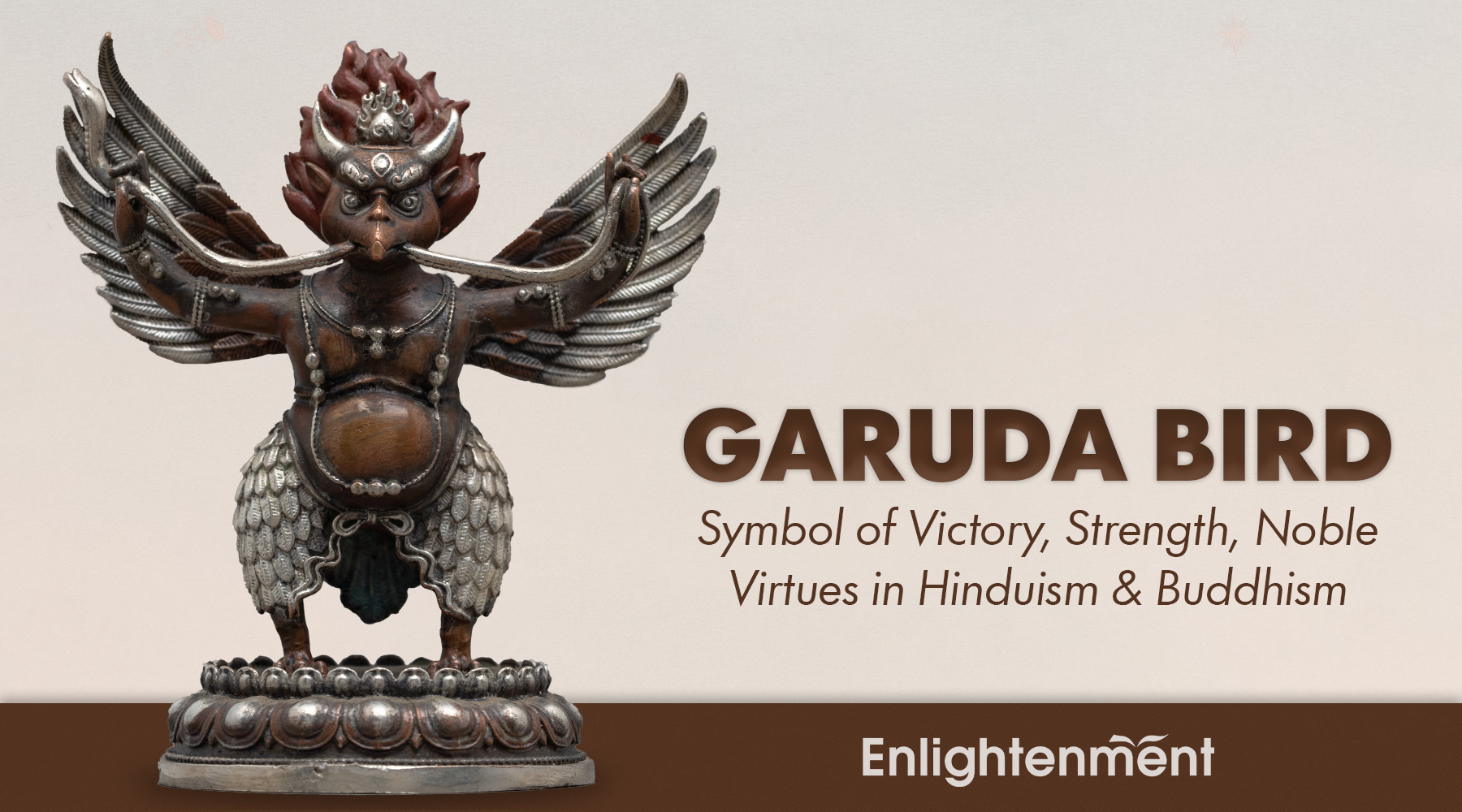Garuda: Mythical Marvel of Ancient Legends:
Garuda, famously known as 'the devourer,' is a renowned figure in both Hindu and Buddhist mythology, where he is referred to as the mythical 'Lord of Birds.'
According to the Hindu Puranic legends, Garuda's origins trace back to his parents, father Kashyapa and mother Vinata. As the tale goes, Garuda was hatched from an egg after a prolonged incubation period of five centuries. His mother Vinata delivered the egg at his 'first birth,' and the momentous occasion saw the emergence of the fully-grown Garuda.
The momentous emergence of Garuda from his egg was a spectacle that instilled great fear in those who beheld it. His form was so formidable that it seemed to fill the skies, and the flapping of his wings created a great disturbance, shaking the very earth beneath him. His body, composed of a brilliant gold hue, radiated an intolerable luminosity that caused even the gods to mistake him for Agni, the revered god of fire. In this manner, the frightening and awe-inspiring Garuda rose from his egg, revealing himself in all his glory.
The Tale of his Immortality
In a significant turn of events, Garuda's mother, Vinata, engaged in a heated argument with her sister Kadru over the color of a horse's tail. The horse in question was none other than Uchaishravas, who had emerged from the churning of the primal ocean. Kadru, being the mother of the serpents, held Vinata captive in her serpent-pit prison as an act of vengeance.
In a valiant effort to rescue his mother, Garuda made a bold move and stormed the heaven of Indra, absconding with the sacred amrita as a means of payment for the ransom. Though he succeeded in his mission, a few drops of the amrita accidentally fell from his beak onto some kusha grass during the transaction. The serpents, taking advantage of this, licked the grass and, as a result, their tongues became forked due to the sharp edges of the grass. The gods struggled greatly to reclaim the amrita from Garuda's beak, and it was discovered that even Indra's mighty vajra was no match for Garuda's formidable body.
Click here to view our Garuda Statue
Such was the immense power and strength of the mighty Garuda, who succeeded in his mission to free his mother and claim the sacred amrita as his prize.
None other than Vishnu possessed the power to control Garuda, who was bound by an unbreakable oath. Vishnu granted him the privilege of immortality and bestowed upon him the role of his divine vehicle. Sadly, most accounts of Garuda's stories from the Vishnu Puranas and Garuda Puranas are now lost to time. However, in later mythology, Krishna, who was recognized as the eighth manifestation of Vishnu, chose Garuda as his mount. The valiant bird's sworn enmity towards serpents and nagas served him well when he defeated the fearsome serpent Kaliya.
Serpents and Preys: The Archetypal Enmity
Across many mythologies, there exists a pervasive archetype of animosity between birds of prey and serpents. The eagles of Sumerian and Greek lore are famous examples, as are the poison-transmuting peacocks of Persia and India. The giant snake-eating Simurgh of Sinbad's adventures in Arabian Nights is yet another fascinating illustration of this archetype.
Garuda in Indian Tradition:
Garuda is known by many names, including Suparna, Garutman, Sarparati, Khageshvara, and Pakshiraj. In Indian mythology, Garuda is considered the "chief of feathered creatures" and is depicted as a great bird. However, his form later evolved into that of a "bird-man," a creature with a human body and a bird's head, talons, beak, and wings. The female counterpart of Garuda is called Garudi.
His artistic representation spread throughout various regions, including India, Nepal, Sri Lanka, Burma, Thailand, and Southeast Asia, in the form of zoomorphic variations. In Bali, his animalistic image gained significant popularity, and he is often evoked to ward off snakes, snakebites, and other types of animal poisonings. In China, he is associated with the God of thunder and is depicted carrying a hammer and chisel, which represent the roar of thunder and flashes of lightning.
Tibetan Implications and Iconography Of Garuda
In Tibet, Garuda became associated with the Bon khading, which is a golden "horned eagle" and the king of birds, as well as the Bon bird of fire. In Tibetan culture, they also associate the white khading with the swan, which is considered the king of water birds. The Tibetan language has two words for the Indian Garuda, which are "khyung" and "mkha' lding."
Tibetan iconography depicts Garuda with the upper torso and arms of a human, while his head, beak, and legs are those of a bird. He is usually depicted with large wings that can unfold from his back, shoulders, or forearms.
He is depicted with ostrich-like lower legs and large clawed feet that end in sharp talons. His feathered thighs end below the waist. He has a feathered back and long tail feathers that reach down to his feet. His curved beak resembles that of an eagle, falcon, or owl, and is as indestructible as meteorite iron, as are his talons. No serpent can survive his iron grip or bite. His wings and eyes are a striking golden color, and the hair on his head blazes upwards, with his eyebrows twisting like fire. Between his sharp horns, there is a head bump that conceals a serpent jewel in his skull, which was stolen from the king of the serpents. Sometimes, the jewel is represented as a head ornament placed above the sun and moon on his crown.
According to other legends, he obtained the serpent jewel from Mount Meru. He swallowed it in secret, and then later vomited it back out. In Tibetan folklore, eagle vomit is considered a remedy for poisoning. The jewel is believed to be a treasure of the serpent king that grants its possessor the power or siddhi of having control over all snakes. It is often represented as a head ornament placed above the sun and moon on Garuda's crown, between his sharp horns.
Garuda is often depicted with a serpent king in his sharp beak, which he devours as a symbol of his victory over serpents. In some texts, he is described as biting the serpent's head while holding its tail in his hands. Artistic representations often show Garuda holding a long snake between both hands and biting it in the middle.
In addition to his triumph over serpents, he is also described as wearing the eight great serpents as ornaments. One serpent binds his hair, two others serve as earrings, two as bracelets, two as anklets, and one as a belt or necklace. This is a sign of Garuda's dominance over serpents and his status as their natural enemy.
Garuda According to Other Traditions
Garuda is revered in various forms across different traditions and lineages. He holds a significant place in the Dzogchen transmissions of both the Nyingma and Bon traditions. He serves as the vehicle of Amoghasiddhi and is also considered the green Buddha of the north, adorning the apex of the Buddhas' enlightenment thrones. In the Nyingma tradition, he embodies the wrathful forms of Padmasambhava.
He is also often depicted as a protector and remover of obstacles in the Vajrayana Buddhist tradition. He is associated with the deity Vajrapani and the horse-headed deity Hayagriva. He is believed to have the power to cure snake bites, kidney failure, plague, and even cancer. In Vajrapani sadhanas, he is sometimes visualized within the body as they assist in removing obstacles and illnesses.
Garuda’s Symbolic Representation
A group of five Garudas represents the wisdom and qualities of the Five Buddha Families. A yellow Garuda represents earth, a white one represents water, a red one represents fire, a black one represents air, and a blue or multi-coloured one represents space. The multi-coloured Garuda is yellow from the waist down (earth) and white from the hips to the navel (water). He's red from the navel to the throat (fire), black from the chin to the forehead (air), and blue or green on his crown (wisdom).
The wings of the multi-coloured Garuda have feathers of five colors, symbolizing the element of space scintillating rainbow light rays in all directions. Sometimes the ends of the wing feathers are vajra-tipped. The yellow or golden Garuda is the most commonly represented form. He has a yellow jewel body that blazes like fire.
His depiction is rich with symbolism and represents various aspects of spiritual and philosophical concepts. His golden wings and trampling on the eight great serpents represent the triumph over negative forces and obstacles. The jewel, sun, and moon on his crest symbolize the balance and integration of various energies and elements.
The union of method and wisdom represented by his two wings indicates the harmony of different approaches and techniques towards spiritual realization. The transmutation of poison into amrita through his form signifies the alchemical transformation of negative emotions and experiences into positive qualities and spiritual realization.
The image of Garuda emerging fully-fledged from the egg is a powerful symbol of spontaneous awakening and realization without effort or external influences. Overall, Garuda is a significant figure in various traditions and holds deep spiritual significance and symbolism.



1 comment
Angie P
I found a Gold/Silver Garuda at the goodwill for $7.99.
I’m doing research on it now. It anyone has any information please contact me through my email.
Thanks